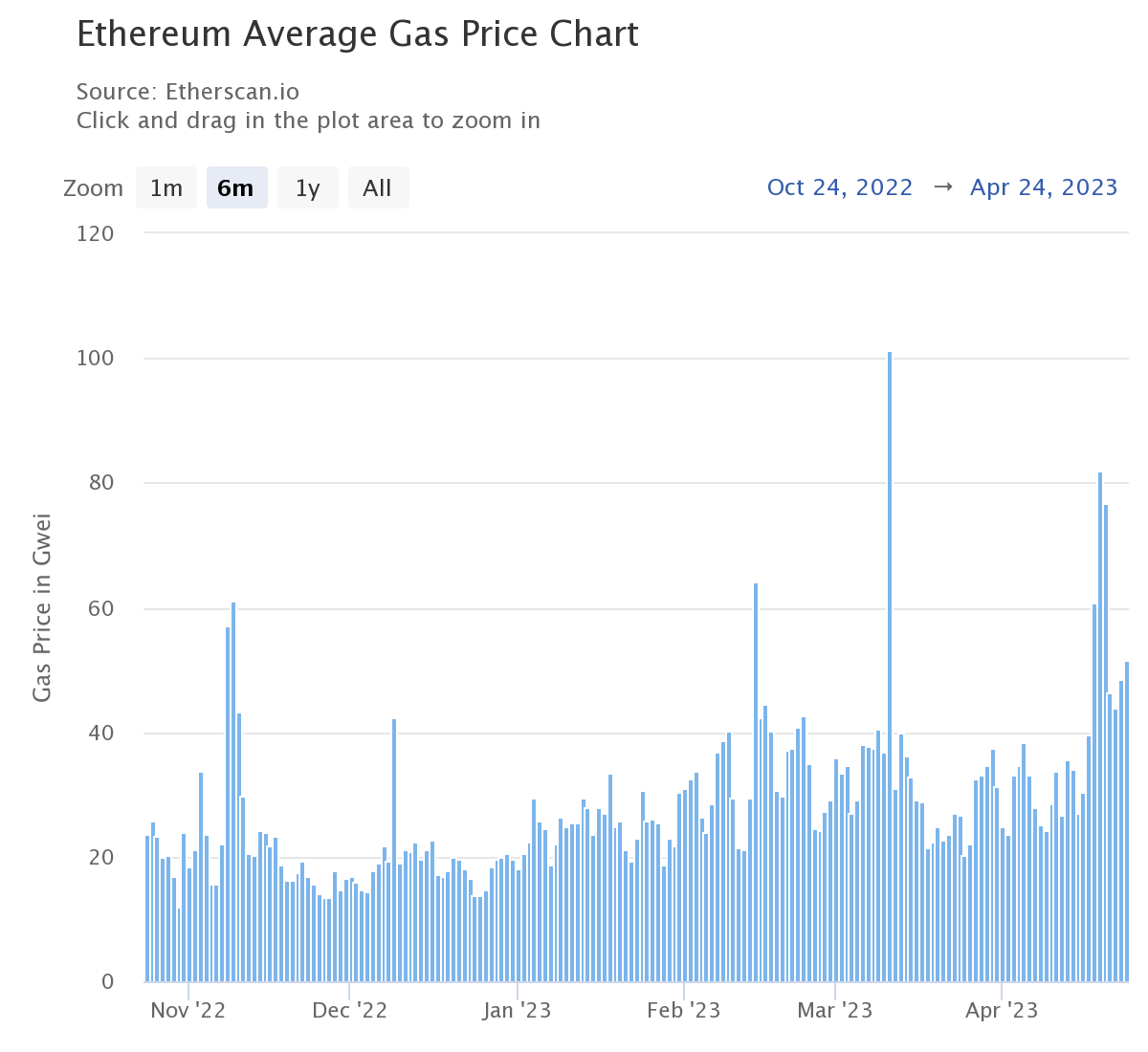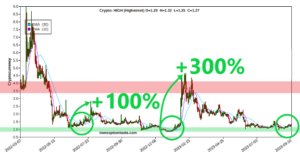During this morning’s Crypto Q&A, someone asked me “why are gas prices so high right now?”
I wouldn’t know. My car is electric.
Oh…you meant Ethereum (ETH) gas prices.
Yeah—they’re stupid expensive right now. I know they broke their 10-month high last week, leaving many investors (including myself) frustrated with gas prices sometimes higher than the value of the transaction itself.
This is a direct result of demand for decentralized applications (dApps), NFT trading, cryptocurrency, and Web3 services reaching an all-time high, which is a net positive for investors.
Unfortunately, Ethereum can’t handle all this new demand. And because gas prices depend on network traffic, supply of validators, and the amount of transactions needing validation—the more people that use Ethereum, the higher that gas prices climb.
That’s because what you’re actually paying for is the amount of computational power required to validate new transactions on the blockchain, the value of which increases with demand.
Ethereum gas is measured in “gwei,” the equivalent of 0.000000001 ETH.
The chart below illustrates how gas fees have steadily increased over the past six months.


But here’s the kicker: higher demand also means a higher price for ETH, which has climbed by 50% in the same time frame.
The more people that use Ethereum…
…the more transactions that need validating…
…and the more money we’re all going to pay to make it happen.
We’re stuck with this problem until Ethereum can increase its transaction capacity, or another blockchain replaces it as the leading Web3 platform.
So, while we can’t avoid these fees entirely… I can show you three ways to pay less.
Here are three tips for avoiding high gas fees:
#1 – Avoid Rush Hour
Cryptocurrency has peak traffic times, too. Gas fees are typically lower during off-peak hours when the network is less congested. You can time your transactions for these periods to save money on gas fees.
Gas prices are currently at their lowest between midnight and 4 a.m. (EST) on weekdays, and between 2 a.m. and 3 a.m. (EST) on weekends.
Use this chart to find out when gas fees will be their lowest and try to time your transactions for off-peak times.
#2 – Use Exchanges that Bundle Transactions
Decentralized exchanges (DEXs) like Uniswap can help save you money on Ethereum gas fees by bundling multiple transactions into one.
Uniswap does this using a market maker (AMM) model instead of a traditional order book that relies on liquidity pools to facilitate transactions, reducing the need for complex gas fee calculations and lowering the overall cost.
You can use Uniswap to convert Ethereum into other ETH-based cryptocurrencies for typically lower gas fees than what you’d find on MetaMask
Not familiar with Uniswap? Start here.
#3 – Utilize Layer-2 Solutions
One of the best ways to avoid high gas fees on Ethereum is by utilizing Layer-2 protocols like Polygon (MATIC).
Layer-2 protocols have become vital scaling solutions for Ethereum by offloading transactions and validating them on a “sidechain” adjacent to the mainnet. We can access these sidechains and use them to conduct transactions for lower fees and faster processing times.
The most popular Layer-2 network for ETH is currently Polygon. To use Polygon instead of Ethereum, you’ll need to own MATIC and connect to the network via MetaMask.
Learn how to use Polygon here.
But there’s another Layer-2 network I haven’t mentioned here that I think is going to outperform Polygon long-term. I’m building my position in it right now, and I’m predicting a 10X return over the next three to five years.
I’m keeping this asset hidden for now…unless you’re subscribed to Digital Fortunes Network, in which case you can check out your April pick here.
Stay liquid,
Nick Black
Chief Crypto Strategist, American Institute for Crypto Investors
- SEO Powered Content & PR Distribution. Get Amplified Today.
- PlatoAiStream. Web3 Data Intelligence. Knowledge Amplified. Access Here.
- Minting the Future w Adryenn Ashley. Access Here.
- Source: https://aicinvestors.com/article/three-tips-for-avoiding-ethereums-high-gas-fees/
- :has
- :is
- a
- access
- actually
- adjacent
- All
- also
- AMM
- amount
- an
- and
- Another
- applications
- Applications (DApps)
- April
- ARE
- AS
- asset
- At
- avoiding
- BE
- because
- become
- below
- BEST
- between
- blockchain
- book
- Broke
- Building
- Bundle
- by
- CAN
- Capacity
- car
- case
- Chart
- climb
- Climbed
- complex
- computational power
- Conduct
- Connect
- convert
- Cost
- crypto
- Crypto investors
- cryptocurrencies
- cryptocurrency
- Currently
- DApps
- decentralized
- Decentralized Applications
- Demand
- DEXs
- direct
- during
- Electric
- Equivalent
- ETH
- ethereum
- Ethereum Gas
- Ethereum's
- Exchanges
- expensive
- facilitate
- familiar
- faster
- fee
- Fees
- Find
- For
- For Investors
- fortunes
- FRAME
- frustrated
- GAS
- gas fees
- gas prices
- going
- handle
- happen
- Have
- help
- here
- Hidden
- High
- higher
- HOURS
- How
- How To
- HTTPS
- i
- illustrates
- in
- Including
- Increase
- increased
- Increases
- instead
- Institute
- into
- Investors
- IT
- ITS
- itself
- keeping
- Know
- Last
- leading
- leaving
- like
- Liquid
- Liquidity
- liquidity pools
- long-term
- lowering
- mainnet
- make
- maker
- many
- Market
- market maker
- Matic
- max-width
- means
- mentioned
- MetaMask
- model
- money
- months
- more
- most
- Most Popular
- multiple
- Need
- needing
- net
- network
- network traffic
- New
- next
- NFT
- NFT trading
- now
- of
- on
- ONE
- or
- order
- Other
- Outperform
- over
- overall
- own
- past
- Pay
- paying
- Peak
- People
- periods
- pick
- platform
- plato
- Plato Data Intelligence
- PlatoData
- Polygon
- Pools
- Popular
- position
- positive
- power
- predicting
- Premium
- price
- Prices
- Problem
- processing
- protocols
- reaching
- reducing
- required
- result
- return
- rush
- same
- Save
- scaling
- Services
- show
- Sidechains
- SIX
- Six months
- So
- Solutions
- Someone
- Strategist
- supply
- than
- that
- The
- their
- Them
- These
- they
- this
- three
- time
- times
- tips
- to
- too
- Trading
- traditional
- traffic
- transaction
- Transactions
- typically
- Uniswap
- use
- using
- utilize
- Utilizing
- VALIDATE
- validators
- value
- via
- vital
- ways
- we
- Web3
- Web3 services
- week
- What
- when
- which
- while
- will
- with
- years
- you
- Your
- zephyrnet












